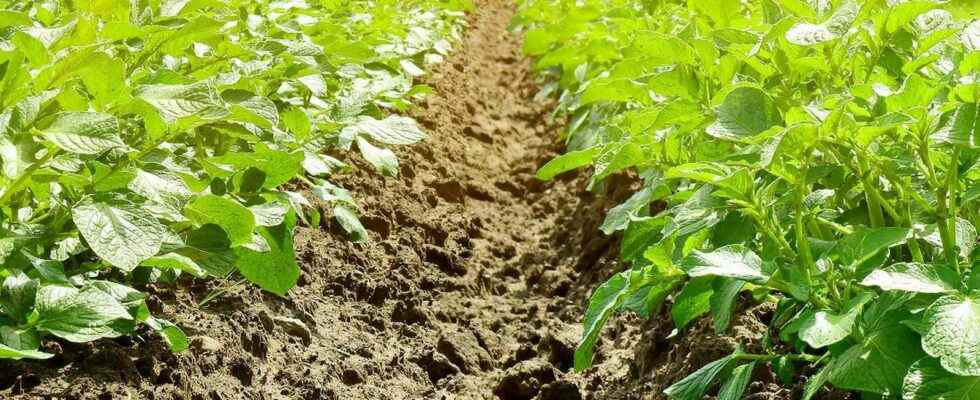In summer, periods of intense heat and heat waves are more and more frequent and not only in the south but everywhere in France. It is therefore necessary to adapt the vegetables to be grown in the vegetable garden or to take precautions so that they endure these extreme conditions.
You will also be interested
[EN VIDÉO] Garden: 5 flowers that tolerate drought well All plants need water to live. But some tolerate long periods of drought well. With these 5 flowers, the chore of watering is over!
The drought may not be suitable for some families such as fruiting vegetables which will require too much water. As for root vegetables, they are generally more resistant. Water restrictions, little shade, sun rays Sun burning, all signs that can damage vegetable production. Here are eight drought-tolerant vegetables.
Potatoes
Once planted in the spring, the potatoes do not require much maintenance. Grown in full sun, mounded to protect the tubers of the lightthem potatoes adapt easily to these periods of heat. Nevertheless, the harvests from June until August can be less generous. You may see lower yields with smaller potatoes. Even if we favor old varieties such as ‘Rouge des Flandres’, ‘Vitelotte’ or ‘Corne de Gatte’ which are more resistant to this aridity, the harvest is likely to be low.
red beets
Sown from March to June, the Red beets grow over the months. When a period of drought hits, they adapt to these harsh conditions with their underground roots. Hoe the rows all summer long to break the crust superficial and allow the little water that has fallen from the sky or brought by the gardener to pass.
Consider recycling vegetable and fruit washing water instead of throwing it away
Weed the feet because weeds tend to draw the little moisture present in the soil. You may find by eating them that they are fibrous for lack of water but quite tasty.
Carrots
Root vegetables, old varieties of carrots such as ‘De Carentan’, ‘Orange de Colmar à coeur rouge’ or ‘Marché de Paris’ are resistant to drought. Mulching can slow soil drying out and retain moisture needed for plant growth. carrots. Think of to recycle washing water from vegetables and fruits instead of throwing it away. In case of water restrictions, use water from your reserve to bring a minimum of water.
The salads
Whether they are chicory where the Romanesquegrow only heirloom varieties that will be more resistant to heavy heat summer. Avoid Batavia lettuces which consume a lot of water to grow. Shade the rows or squares as much as possible with crates, reeds or shade sails.
How to use jar irrigation with an olla?
Lettuces can stress in this heat, be less vigorous and go to seed quickly. You can also use ollas in the salad rows, provided you are not in an area with water restrictions. If this is the case, keep the water used to wash fruits and vegetables and water the salads preferably in the evening.
Beans
The first ones beans sown in May have reached maturity without suffering the vagaries of drought. Those, sown from June, will grow more slowly with the heat and the lack of water. Once the young plants come out of the ground, hoe and mulch the soil to maintain the humidity necessary for the growth of these vegetables. Recycle fruit and vegetable washing water daily. Dwarf beans will benefit from the shade of pole beans planted nearby. Sown in pots, you can move it to shade it. If you are lucky enough to have a water supply, continue watering with this collected water. With the heat and the lack of water, the harvests are likely to be less fruitful.
Cabbage
With their tough leaves, all cabbages and more particularly Brussels Where applesare resistant to drought conditions in the garden and tolerate heat quite well unlike cauliflower.
The peas
The peas and the Chickpeas do not suffer from the heat only if they are already well developed. Young seedlings may not rise or dry out young plants with lack of water and too much sun. The already well-formed pods tolerate the heat but remember to mulch the feet with waste clippings or straw to retain as much water and moisture as possible.
Onions, shallots and garlic
These bulbs that grow underground are less affected by drought. Soil preparation is essential for cultivating onionsI’garlic and the shallots. It must be prepared thoroughly to be loose and allow water or drops of dew. Hoeing during cultivation is therefore important. The only risk noted on these bulbous plants when the drought is long durationit is the bursting of the bulbs.
Interested in what you just read?
